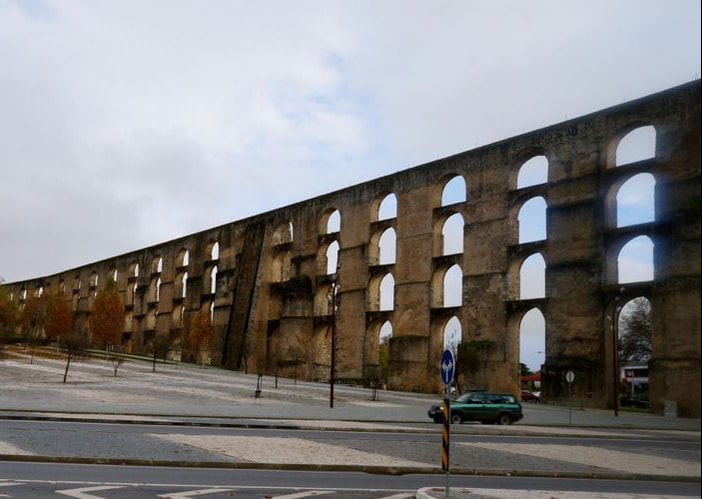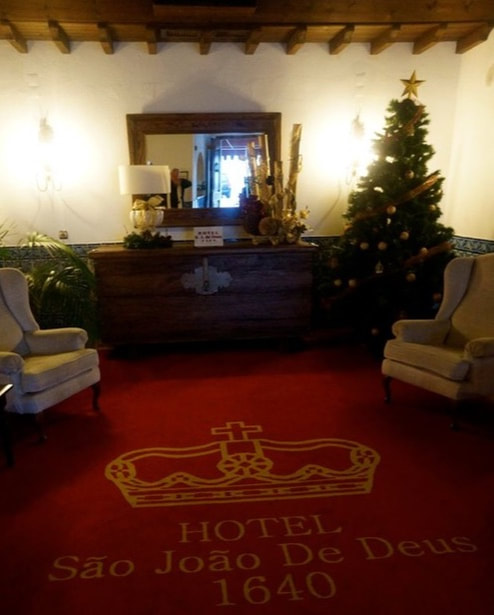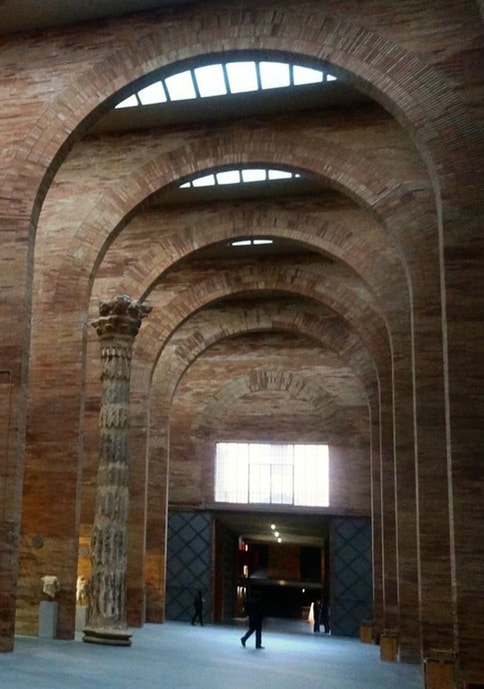Elvas: Portugal"s Garrison Town
If you love megaforts, you will love Elvas. The major challenge for Portugal after independence in 1640 was to protect itself from Spain. Both countries are rough, so you're either on the road or your soldiers are hiking up mountains.
Elvas was Portugal's largest frontier fort on the road from Madrid to Lisbon, and it remains one of the great fortresses in Europe.
Elvas was Portugal's largest frontier fort on the road from Madrid to Lisbon, and it remains one of the great fortresses in Europe.
Following the steps of Duke Wellington in his defense of Portugal from Napoleon's armies in Spain was the primary purpose of our trip to Portugal and Spain, so it was inevitable that we ended up in Elvas.
It's almost next door to Badajoz, the next Spanish border fort and that was one city we had to see, so popping over to Elvas was an easy jaunt. It provided a view of the fantastic countryside as we drove.
It's almost next door to Badajoz, the next Spanish border fort and that was one city we had to see, so popping over to Elvas was an easy jaunt. It provided a view of the fantastic countryside as we drove.
Once there, it became a perfect centre for us to make day trips to small towns and become much more comfortable with Portuguese history and architecture.
Tourist brochures tend to push places that are already famous on the assumption that you can't visit everything, but this cheats you out of the many significant marvels that nations have developed over their history and then forgotten in the rush of modern life only to be rediscovered by historians in the modern age. Elvas is the centre of this kind of rediscovery.
Located in Alentejo, a region known for its wine and savories, Elvas is known for its olives and plums, and sampling these from its many restaurants is quite an experience.
The Girassol was our victim for the night, and Mom and Dad were great cooks and superb hosts without blowing Grumpy's budget.
The Girassol was our victim for the night, and Mom and Dad were great cooks and superb hosts without blowing Grumpy's budget.
What to See in Elvas
Elvas was declared a UNESCO World Heritage City on 30 June 2012. Some of what the city offers are:
With the demise of the Moors, there followed a medieval wall called the Fernandina, built of massive stone around 1350. But unhappily, the Wall was viewed as a Home Depot-style material supplier to construct the enormous fortification of 1643.
Elvas was declared a UNESCO World Heritage City on 30 June 2012. Some of what the city offers are:
- Forts of Santa Luzia and Nossa Senhora da Graça and the Fortlets of São Mamede, São Pedro and São Domingos.
With the demise of the Moors, there followed a medieval wall called the Fernandina, built of massive stone around 1350. But unhappily, the Wall was viewed as a Home Depot-style material supplier to construct the enormous fortification of 1643.
Portugal was worried about Spain's aggressive intent.
In 1659, the city withstood a siege by Spanish forces for more than three months. Despite food shortages and continuous bombardment, the defenders held their ground and successfully repelled the attackers. This heroic resistance made Elvas a symbol of Portuguese resilience.
This wall would be the cork in the Spanish wine bottle. A Dutch Jesuit brought the most modern geometric theory of Europe to this rough country and designed a fort to fit. It is a masterpiece. The Spanish gave it a pass.
The fort is considered one of the largest and most well-preserved bastion fortresses in the world. It protected the Spanish-Portuguese border and served as a military stronghold.
In 1659, the city withstood a siege by Spanish forces for more than three months. Despite food shortages and continuous bombardment, the defenders held their ground and successfully repelled the attackers. This heroic resistance made Elvas a symbol of Portuguese resilience.
This wall would be the cork in the Spanish wine bottle. A Dutch Jesuit brought the most modern geometric theory of Europe to this rough country and designed a fort to fit. It is a masterpiece. The Spanish gave it a pass.
- The Star Fort of Elvas
The fort is considered one of the largest and most well-preserved bastion fortresses in the world. It protected the Spanish-Portuguese border and served as a military stronghold.
- Amoreira Aqueduct
The aqueduct stretches over 7 kilometers (4.3 miles) and has 843 arches, reaching a maximum height of 31 meters (102 feet). This impressive structure is not only functional but also adds to the city's architectural beauty.
- The Historic Centre
The Praça da República, the main square, is particularly picturesque, with beautiful buildings and a stunning view of the surrounding landscape. Walking through the historic center gives you a sense of the city's past and the cultural influences that have shaped it.
The military museum is worth a visit. By the way, if you're interested in the Peninsular Campaign, the British cemetery just outside of town is beautifully maintained and well worth a visit.
- The Gothic Cathedral of Our Lady of the Assumption
However, Elvas' Our Lady of the Assumption, designed by the Royal architect Francisco de Arruda in the Baroque and Manueline style, was completed in 1537. The staff shared the place willingly, and we were charmed.
It houses a first-class Sacred Art Museum, which is worth visiting. With its paintings and sculptures by the second-tier artists of the day, it displays some of the most interesting historical pieces of the region.
Where to Stay in Elvas
Our hotel, the Sao Joao, had once been a monastery and then, during the Peninsular War, a hospital. However, today, it's a first-class place to stay right downtown with easy parking.
You can walk everywhere from here. The room was huge, and the size of the bathroom made us think that the head of the monastery set up camp there.
There's a wonderful flowered terrace overlooking a beautiful garden, and the nooks and crannies of the hallways are filled with five hundred years of history.
Our hotel, the Sao Joao, had once been a monastery and then, during the Peninsular War, a hospital. However, today, it's a first-class place to stay right downtown with easy parking.
You can walk everywhere from here. The room was huge, and the size of the bathroom made us think that the head of the monastery set up camp there.
There's a wonderful flowered terrace overlooking a beautiful garden, and the nooks and crannies of the hallways are filled with five hundred years of history.
Famous Elvas Fairs and Festivals
Several fairs draw crowds to this city. It would be enormous fun to time your visit with any of these festivals. The most famous are:
1. Feira de São Mateus (Fair of Saint Matthias): This fair, held in late September or early October and dedicated to Saint Matthias, the patron saint of the city, is one of the oldest and most important fairs in Elvas. It dates back to the 14th century.
The fair features various activities, including concerts, exhibitions, traditional crafts, food stalls, and amusement rides. It attracts both locals and visitors from nearby regions.
2. Feira de São Francisco (Fair of Saint Francis): Celebrated in early October, this fair, dedicated to Saint Francis of Assisi, showcases the region's agricultural products, artisanal crafts, and local gastronomy. Visitors can enjoy live music performances, cultural shows, equestrian displays, and traditional games. The fair also has a livestock exhibition and market, where farmers showcase their animals.
3. Festival Internacional de Fortalezas Musicais (International Festival of Musical Fortresses): This music festival occurs in Elvas and other fortified cities across the European continent. It aims to promote cultural exchange and enhance music appreciation in historic settings.
The festival features a diverse range of musical genres, including classical, jazz, folk, and world music. Concerts are held in Elvas' historic fortifications, creating a unique and memorable experience for attendees.
4. Festa do Dia do Concelho (Municipality Day Celebration): Elvas celebrates its Municipality Day on January 31st each year. The celebration includes various cultural and recreational activities, such as parades, music performances, dance shows, and traditional costume displays.
The Municipality Day Celebration also highlights Elvas' historical and architectural heritage.
5. Feira de Gastronomia (Gastronomy Fair): This fair promotes the region's culinary traditions and local products. It showcases many traditional dishes, including Alentejo specialties such as migas (breadcrumbs), açorda (bread soup), and various meat and game dishes. Visitors can explore food stalls, taste regional products, and attend cooking demonstrations by renowned chefs.
These fairs and festivals offer a fantastic opportunity to immerse yourself in the vibrant culture, traditions, and flavors of Elvas. They provide you with an authentic and enjoyable experience.
Several fairs draw crowds to this city. It would be enormous fun to time your visit with any of these festivals. The most famous are:
1. Feira de São Mateus (Fair of Saint Matthias): This fair, held in late September or early October and dedicated to Saint Matthias, the patron saint of the city, is one of the oldest and most important fairs in Elvas. It dates back to the 14th century.
The fair features various activities, including concerts, exhibitions, traditional crafts, food stalls, and amusement rides. It attracts both locals and visitors from nearby regions.
2. Feira de São Francisco (Fair of Saint Francis): Celebrated in early October, this fair, dedicated to Saint Francis of Assisi, showcases the region's agricultural products, artisanal crafts, and local gastronomy. Visitors can enjoy live music performances, cultural shows, equestrian displays, and traditional games. The fair also has a livestock exhibition and market, where farmers showcase their animals.
3. Festival Internacional de Fortalezas Musicais (International Festival of Musical Fortresses): This music festival occurs in Elvas and other fortified cities across the European continent. It aims to promote cultural exchange and enhance music appreciation in historic settings.
The festival features a diverse range of musical genres, including classical, jazz, folk, and world music. Concerts are held in Elvas' historic fortifications, creating a unique and memorable experience for attendees.
4. Festa do Dia do Concelho (Municipality Day Celebration): Elvas celebrates its Municipality Day on January 31st each year. The celebration includes various cultural and recreational activities, such as parades, music performances, dance shows, and traditional costume displays.
The Municipality Day Celebration also highlights Elvas' historical and architectural heritage.
5. Feira de Gastronomia (Gastronomy Fair): This fair promotes the region's culinary traditions and local products. It showcases many traditional dishes, including Alentejo specialties such as migas (breadcrumbs), açorda (bread soup), and various meat and game dishes. Visitors can explore food stalls, taste regional products, and attend cooking demonstrations by renowned chefs.
These fairs and festivals offer a fantastic opportunity to immerse yourself in the vibrant culture, traditions, and flavors of Elvas. They provide you with an authentic and enjoyable experience.
Day Trips from Elvas
Strategically located for day trips to towns of both Portugal and Spain, from Elvas, we took some lovely drives which brought us to some of the most wonderful medieval villages we have seen in Europe.
Strategically located for day trips to towns of both Portugal and Spain, from Elvas, we took some lovely drives which brought us to some of the most wonderful medieval villages we have seen in Europe.
- Evora
There is also a museum displaying the collection of a priest. Its quite a collection showing how much richness the Church really have.
Evora managed to miss the great earthquake of 1755 which hammered Lisbon and much of southern Portugal.
As a consequence, the history of the city from the time of the Celts through the Romans, Visigoths, Moors and Christians can all be seen in bits and pieces happily living together, well displayed and well protected. It's small enough to catch everything with a good walk and is very photogenic.
Close by is the tiny village of Almendres where you can be in the midst of mystery: The Cromlech. This is none of the biggest megalithic structures in Europe.
- Evoramente
Your introduction as you enter is that of a small medieval village that really hasn't moved on much in a century or so. The town was closed for the mid-afternoon mega break so we drifted on to the next town to find something to eat.
- Badajoz
The tourist information centre was the best we’d had in this trip. They even gave us posters of some of the battles that took place there.
We went to the Palace and imagined the battle from there, at least what we could see.
Merida
What a surprise. The town seems to be off the radar when we had done our planning but we kept reading when we were driving and this jumped out of the iPad as the place to see. It has a reputation for tapas but our experience was pretty average.
What a surprise. The town seems to be off the radar when we had done our planning but we kept reading when we were driving and this jumped out of the iPad as the place to see. It has a reputation for tapas but our experience was pretty average.
The Museum is an architectural gem and because Merida had such a long history of wealthy Roman occupants, the display of mosaics on the walls of the Museum and the massive statues are superb. We will never doubt the wealth of Rome as displayed in its colonies ever again.
Before you go, check out these other articles on Portugal:












